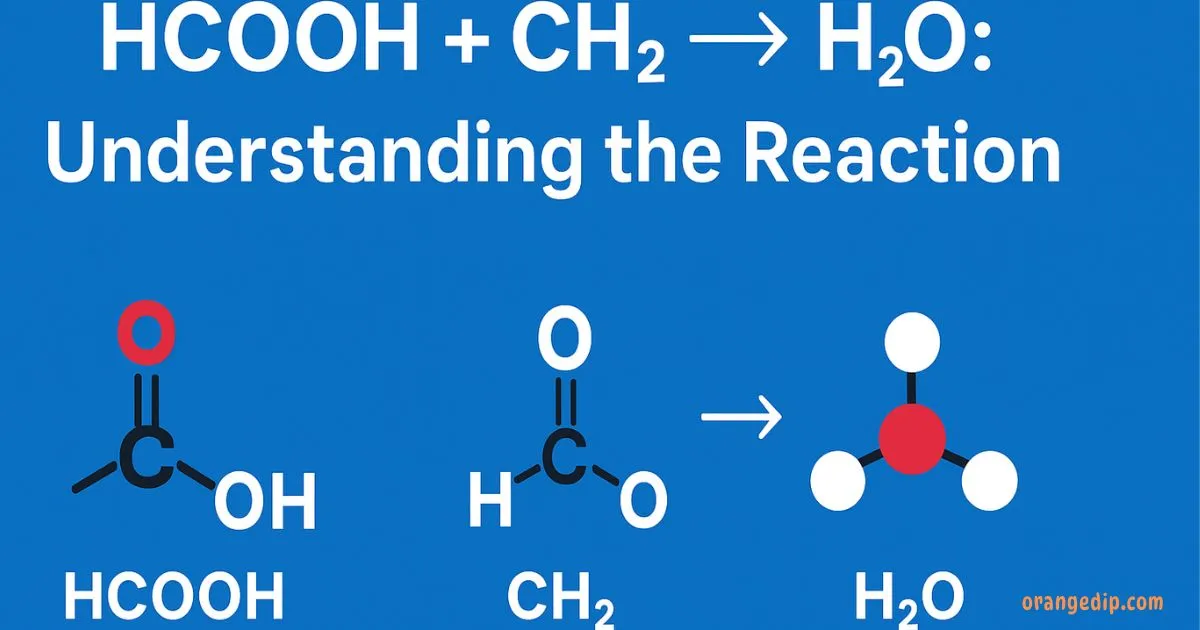Chemistry often looks intimidating with its formulas and symbols, but once you break things down, everything becomes surprisingly simple. The expression HCOOCH₃ + CH₂ + H₂O involves three very common yet fascinating components used in organic chemistry. Let’s unravel them one by one so the entire concept becomes crystal clear.
What is HCOOCH₃?
HCOOCH₃ is known as methyl formate, an ester formed from methanol and formic acid. It has a fruity smell, evaporates easily, and is widely used as a solvent in industries.
What is CH₂?
CH₂—also called methylene—is a highly reactive chemical species. You can think of it as a short-lived building block that helps create larger organic molecules.
What is H₂O in This Context?
H₂O is just water, but in chemistry, it’s much more than a drink. Water often controls whether a reaction speeds up, slows down, or completely changes direction.
Breaking Down the Reaction
To understand the combination of these three compounds, we must look at how they behave when mixed.
Why These Compounds React
Esters like methyl formate tend to react with water in a process called hydrolysis, while methylene (CH₂) is so reactive that it eagerly bonds with almost anything nearby.
Common Conditions Required
For this reaction to make sense, certain conditions must be present:
-
Controlled temperature
-
Adequate moisture
-
Possible catalysts (like acids or bases)
Temperature and Pressure Factors
Most hydrolysis reactions occur faster when heated. In industrial settings, pressure may also be adjusted to make the reaction more efficient.
The Role of Methyl Formate (HCOOCH₃)
Structure and Properties
Methyl formate consists of a formyl group (HCOO–) attached to a methyl group (–CH₃). This ester bond is vulnerable to attack by water molecules.
Industrial Uses
You’ll find methyl formate in:
-
Leather finishing
-
Pharmaceutical synthesis
-
Perfume production
-
Solvents and adhesives
Why It Reacts Easily
Its ester bond is not very strong, making it ideal for controlled chemical breakdowns.
The Function of CH₂ (Methylene)
How Reactive CH₂ Is
CH₂ is like the “hyperactive child” of organic chemistry—it’s extremely reactive because it lacks electrons needed for stability.
Its Use in Organic Synthesis
Chemists use CH₂ units to create:
-
Polymers
-
Complex hydrocarbons
-
Organic intermediates
It acts as a connector, linking molecules into larger structures.
Importance of Water (H₂O)
Hydrolysis Reactions
Water easily breaks down esters like methyl formate into:
-
Formic acid
-
Methanol
This process is essential in industries that need pure components.
Water as a Catalyst or Reactant
Water sometimes helps reactions without being consumed, while at other times it becomes an essential ingredient.
Expected Products of the Reaction
Combining HCOOCH₃ + CH₂ + H₂O typically leads to:
Possible Hydrolysis Products
-
Methanol (CH₃OH)
-
Formic acid (HCOOH)
Organic Byproducts
CH₂ can attach to various parts of the ester components, forming new carbon-based compounds.
Real-World Examples
These reactions appear in:
-
Polymer industries
-
Pharmaceutical labs
-
Fuel processing plants
Practical Applications
Industrial Chemistry
Hydrolysis reactions help produce raw materials for manufacturing solvents and plastics.
Organic Synthesis
Chemists rely on CH₂ to upgrade simple molecules into more useful ones.
Environmental Chemistry
Understanding how esters break down helps researchers study pollution and biodegradation.
Safety Considerations
Handling Raw Chemicals
Both methyl formate and methylene require proper ventilation and protective equipment.
Storage and Stability
-
Methyl formate must be stored away from heat.
-
CH₂ is too reactive to store freely and is usually generated on-site.
Comparing With Similar Reactions
Ester Hydrolysis
Methyl formate behaves like most esters—it breaks down predictably in water.
Reactions Involving CH₂ Compounds
CH₂ reactions resemble other carbene reactions, where small reactive species build bigger organic structures.
Conclusion
The reaction HCOOCH₃ + CH₂ + H₂O may look complicated at first glance, but once you break it down, it becomes easy to understand. Methyl formate undergoes hydrolysis with water, while CH₂ enhances the complexity of the reaction by bonding with different molecular fragments. These concepts are essential in industries like manufacturing, medicine, and environmental science.
Understanding each component helps you appreciate how everyday products—from solvents to plastics—are created through simple but powerful chemical reactions.
FAQs
1. What is the simplest way to understand this reaction?
Think of it as an ester breaking apart in water while a reactive CH₂ group forms new compounds.
2. Is methyl formate (HCOOCH₃) dangerous?
It’s safe with proper handling but flammable and should be used in ventilated areas.
3. Does water always cause hydrolysis?
Not always. Hydrolysis depends on conditions like pH, temperature, and catalysts.
4. Can CH₂ exist freely?
Not for long. It’s extremely reactive and usually forms immediately into another compound.
5. Where is this reaction commonly used?
In manufacturing solvents, polymers, pharmaceuticals, and organic intermediates.
